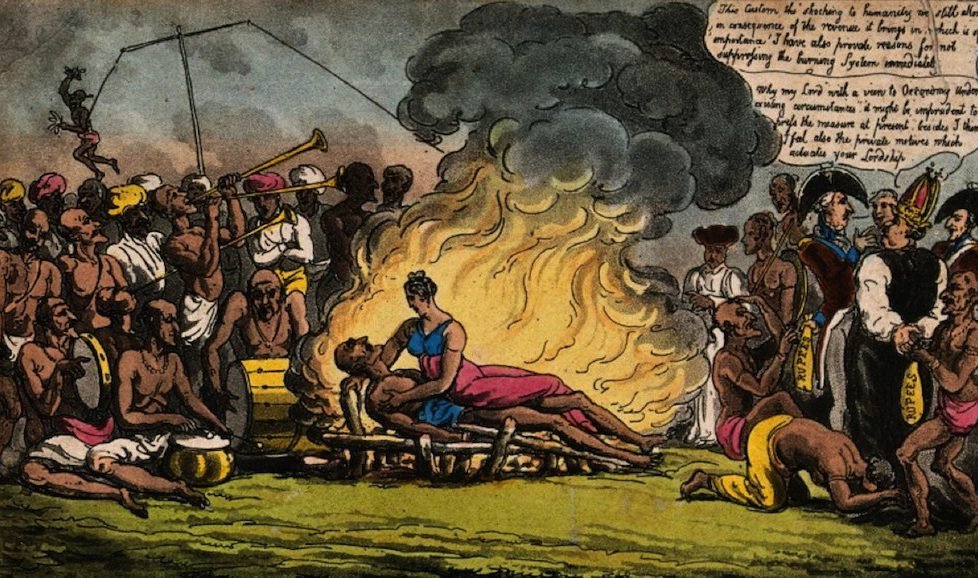SATI Pratha: We know Nothing About


Sati is a practice of self-immolation or committing suicide after of their husband’s death, intentionally or by a social pressure.
Up-written statement is what we have been taught since childhood about Sati Pratha. We even read that it was abolished by the then Governor General Lord William Bentinck with the help of the Social reformer Raja Ram Mohan Roy. And we learnt it by heart and wrote paragraphs about how evil Indian Society has been to Women, when asked to write essays about it. But neither of us cared to know what actually is Sati Pratha. We ain’t keen to know things out of our syllabus. We only intake what is served on our plate. This is in our genes.

Lets see how women were treated thousands of years ago.
The Indus Valley Civilisation and the Vedic Age
The archaeologists have found sculptures which depicted women as priests. Many hymns in our Vedas are written by Rishikas(women as rishis). The ‘Gurus’ at Gurukuls were mostly women. Then women were considered as deity. They were respected and praised. They were included while making decisions, in the family.
The Rig Veda (10:18:7-8) describes a cremation where a widow who was lying beside her dead husband was not allowed to kill herself.
Through many texts and excavations, it is evident that during the Vedic period, Sati was an exceedingly uncommon practice.
Now, what brought changes were the Mughals and the invaders who came to India during 11th-14th century. They started taking over Indian territories, killed our kings and took over their kingdom. What they did to women was worse. The women living in the kingdom took over by the Mughals, were harassed, enslaved and raped brutally. You see, that was the time when the position of women started deteriorating. And then Jauhar came into existence.
Jauhar is the act of mass self-immolation by women in parts of the Indian subcontinent, to avoid capture, enslavement and rape by foreign invaders, when facing certain defeat during war.

It was practised by Rajputs, mainly in Rajasthan. They considered death to be better than being enslaved by the invaders.
When British came to India, they have had two clear strategies:
In the early 1800s, British colonisers sensationalised the obscure tradition by bringing it into limelight. They completely changed the way Sati System was practised and started spreading rumours.
OKAY!!!!!!! First lets find how it was actually practised.
It was mostly practised by the tribal of India. Not every society of India practised Sati, FYI. So, what actually happened when a man died was, his wife along with others went to the cemetery. After all the rituals the wife started taking rounds around the pyre and recited some Sanskrit mantra. After the first round she stops and asks her family, whether they are ready to take up her responsibilities and keep her safe. If they agreed, she went with them. If not, then she takes another round and asks the prominent people of her tribe and then to the priests and then so on. If none agreed, she lived in a temple, alone.
Bentinck took advantage of Indians deep belief in religious rituals and manipulated Sati Pratha and pretended to save women dignity in India while his own country was practising ‘Witch Hunting’ (widows were killed as they were considered witch).
By now, missionaries too came into existence. Though, Britishers never wanted Missionaries to enter India because Britishers only motive was to earn money. But missionaries took advantages of the rumours spread about Sati Pratha. They pretended before the parliament that India is a country of evil practises and they are much needed there.
Missionaries wrote all the rumours as our history in the textbooks, they taught. And our government never cared to enlighten us with truth. All we read is completely biased. Our course book hugely discuss about the Europe’s Renaissance, their Industrial Revolution but never mentioned anything about ‘Witch Hunting’, while Sati is glorified in textbooks, since our childhood.
DISCLAIMER: The author is solely responsible for the views expressed in this article. The author carries the responsibility for citing and/or licensing of images utilized within the text.
